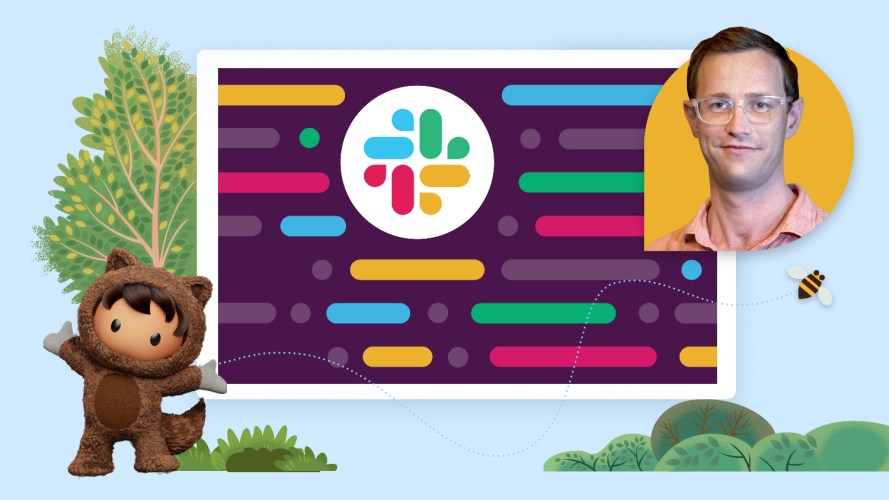How to Make Design Research Neurodivergent Friendly

Using Slack, one Trailblazer shaped his research approach to minimize bias and support people with ADHD, dyslexia, autism, and other information processing needs.
Tim Smyth, Trailblazer, and #DreamDesigner, understands how traditional research methods tend to leave out people who identify as neurodivergent.
Surveys rely on strong recall skills, which may be challenging for those with ADHD. Focus groups can misinterpret behavioral sentiments such as eye contact aversion associated with autism. Plus, platform metrics may ignore UX accessibility pitfalls. (For example: Some form fields display text disappears upon selection.)
Given about 10 to 20 percent of the global population is neurodivergent, that excludes many respondents. So when Smyth began design research for an employee experience (EX) project, he committed to making it inclusive. To do this, a real-time, conversational feedback tool proved extremely valuable.
As someone whose own experience includes autism spectrum disorder (ASD) and attention-deficit/hyperactivity disorder (ADHD), Smyth turned to Slack. He noticed how the productivity platform also supported the ways many of his neurodivergent respondents preferred to communicate. “I had to meet people where they were,” said Smyth.
A new channel sparked active conversation among employees who identified as neurodivergent. This includes those with ADHD, autism, dyslexia, epilepsy, Tourette’s, and other conditions that differ from neurotypical brains. Each one has its own strengths and challenges. Employees trusted Smyth and appreciated that he adapted the feedback method for them. It even improved the quality of the research results.
Building trust
Slack worked in ways that traditional research methods didn’t. Neurodiverse employees offered ideas in an unstructured way, which felt more natural to many than forms or surveys. Using Slack’s strong keyword search, Smyth identified additional like-minded folks who also joined the private channel.
As the community grew, so did trust among users. Trust is always a foundational element in design research. And, this was especially critical for a personal topic such as neurodivergent employee experiences in corporations that aren’t always set up for them.
Fast, honest feedback
Neurodivergent people may struggle with recall when responding to surveys or focus groups. This can lead to research results that are impacted by recall bias. Instead, Slack is built to be real-time. Smyth’s respondents flagged pain points when they happened.
“We are dealing with something that is in their everyday work lives – habits, circumstances, reactions, feelings, thoughts,” Smyth said.
Many channel members also liked the open-ended field. It allowed them to communicate in ways that suited them best. Some people attached screenshots. Some wrote detailed long-form shares and others preferred bullets. This tracks with guidance in a 2023 study published by Cambridge University Press on behalf of the Society for Industrial and Organizational Psychology:
“Qualitative methods can benefit neurodiversity literature by enabling neurodivergent participants to provide open responses that are less restricted compared to pre-generated quantitative scale items, which can reflect professional researchers’ preconceived notions.”
Made for people. Built for productivity



Many active, threaded conversations surfaced in the members-only channel. Respondents were more willing to share their truths and even to disagree in this safe space. The way Smyth conducted the design research effectively reduced social desirability bias (the instinct to say what others want to hear). It also lowered sentiment analysis bias (misinterpreting behavior and emotions).
He credited a more accurate sentiment analysis to the shared universal language of emojis. Smyth describes Slack emoji reactions as a pulse check akin to a net promoter score (NPS), a standard key performance indicator measuring affinity. In this case, it showed the strength of the employee-employer relationship.
In the end, the channel surfaced key employee experience challenges to solve.
Insights from inclusive design
Smyth identified many themes in his research results. Given previous design research didn’t modify communications for neurodivergent employees, many issues had gone unrecognized for far too long.
“Inaccurate or ill-considered design research can create invisible users,” he said, noting that you can’t solve problems that go unidentified.
Researchers benefit from recognizing that people process information differently. Smyth encourages everyone to start with: “How do you prefer to be communicated with?” When he put this into action on his EX project, he received useful feedback. It’s something he also relates to on a personal level. His own neurodivergence is something he now thinks of as his superpower in design.
Designing for accessibility
While he doesn’t claim to speak for the neurodivergent population, Smyth emphasizes the value of neurodivergent people designing research for all.
“When we look at user journeys and empathy maps, we’re superstars at this sort of thing,” Smyth said. “We’ve been thinking about this our whole lives, wondering what other people are thinking about.”
The Cambridge study reinforces the inclusion of neurodivergent researchers. Also consider Article 9 from the United Nations Convention on the Rights of Persons with Disabilities (CRPD): we must “enable persons with disabilities to live independently and participate fully in all aspects of life” and “ensure to persons with disabilities access, on an equal basis with others, to… information and communications technologies and systems.”
Smyth points out that it’s the right thing to do and it’s also the compliant thing to do.
“Finding creative ways to amplify the voices of neurodivergent people in design research can make the research experience better for everyone,” said Holly Prouty, Salesforce Lead Researcher, Research and Insights. “It can also boost the quality of research output.”
Recommendations for how to conduct inclusive design research
Based on Smyth’s experience, there are a few takeaways for anyone working on similar projects.
- Recognize that people process information and communicate differently.
- Include neurodivergent researchers in the planning process.
- Consider tools that support inclusive design research. Smyth selected Slack for how:
- Real-time feedback mitigates recall bias
- Open-ended structure supports varying communication styles
- Private channel enables safe social discourse
- Emojis reduce sentiment analysis bias
Get ready to embrace design
Meet our designers, follow our social platforms and see what we’re working on.



It’s good to remember that neurodiversity presents differently in each individual, so their needs vary. Smyth admits he still has much to learn and, indeed, there is peer-reviewed research coming out almost every day for neurodiversity. As more research institutions receive funding, we’re finally starting to fill in the gaps in the areas we don’t understand. While this knowledge grows, there’s an opportunity for researchers and UX designers to ensure design research is neurodivergent-friendly. Smyth cites the powerful slogan: “Nothing about us, without us.”
“Without integrating neuro-inclusive practices in the design research phase, you’re most likely going to design the wrong thing for the user.”






























